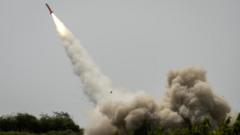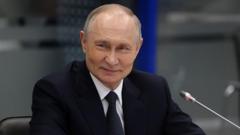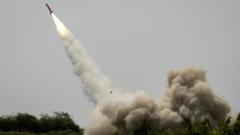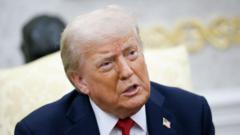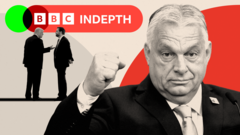On the 100th day of Trump’s second term, his policies are causing division, from tariffs impacting businesses to growing scrutiny over administration actions.
Trump’s Turbulent 100 Days: A Mixed Bag of Policies and Controversies

Trump’s Turbulent 100 Days: A Mixed Bag of Policies and Controversies
Examining the highs and lows of Trump's latest administration phase.
In a whirlwind of initiatives and dramatic policy shifts, President Donald Trump marked the 100th day of his second term yesterday with a trip to Michigan, emphasizing his push to revive American manufacturing. Central to his visit was the reconsideration of auto tariffs, a move that aims to ease the pressures mounting on U.S. businesses due to ongoing trade disputes.
The imposition of tariffs has severely affected various sectors across the U.S., notably prompting toy retailers to pause their holiday stock orders, thereby creating supply chain disruptions. Amidst the fray, pressure from the White House has also targeted major corporations like Amazon, chastising them for possibly suggesting price increases related to tariffs, a claim the retailer firmly denied.
Trump’s recent term has been characterized by chaotic policy announcements and swift reversals that leave many questioning the coherence of his agenda. His cryptocurrency venture, World Liberty Financial, has blurred the lines between governmental and private sector interests, drawing scrutiny over potential conflicts of interest.
Despite repeated assertions by Trump justifying his policies, many of his claims have been challenged and fact-checked, unveiling a plethora of misinformation. On the international front, Chinese giants like Alibaba are now aiding vendors in seeking markets outside the U.S., a response to the tariff crisis.
Domestically, House Republicans have proposed a controversial initiative to impose a $1,000 fee on migrants seeking asylum. In addition, federal watchdogs have initiated multiple investigations into accusations that the Trump administration improperly withheld vital funds that Congress had already allocated.
Notably, Adidas has sounded alarms over potential price hikes for its sneakers in the U.S. due to tariffs, while the administration faces backlash for terminating the employment of hundreds of scientists critical to a major climate report. In an environment of increasing tension and uncertainty, Trump’s approach appears to be sowing division and raising questions about the future economic landscape.
The imposition of tariffs has severely affected various sectors across the U.S., notably prompting toy retailers to pause their holiday stock orders, thereby creating supply chain disruptions. Amidst the fray, pressure from the White House has also targeted major corporations like Amazon, chastising them for possibly suggesting price increases related to tariffs, a claim the retailer firmly denied.
Trump’s recent term has been characterized by chaotic policy announcements and swift reversals that leave many questioning the coherence of his agenda. His cryptocurrency venture, World Liberty Financial, has blurred the lines between governmental and private sector interests, drawing scrutiny over potential conflicts of interest.
Despite repeated assertions by Trump justifying his policies, many of his claims have been challenged and fact-checked, unveiling a plethora of misinformation. On the international front, Chinese giants like Alibaba are now aiding vendors in seeking markets outside the U.S., a response to the tariff crisis.
Domestically, House Republicans have proposed a controversial initiative to impose a $1,000 fee on migrants seeking asylum. In addition, federal watchdogs have initiated multiple investigations into accusations that the Trump administration improperly withheld vital funds that Congress had already allocated.
Notably, Adidas has sounded alarms over potential price hikes for its sneakers in the U.S. due to tariffs, while the administration faces backlash for terminating the employment of hundreds of scientists critical to a major climate report. In an environment of increasing tension and uncertainty, Trump’s approach appears to be sowing division and raising questions about the future economic landscape.


